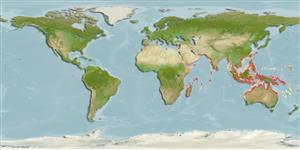Environment: milieu / climate zone / depth range / distribution range
بوم شناسي
دريايي; لب شور; تغييرات عمق 1 - 20 m (Ref. 6898). Tropical; 28°N - 40°S, 21°E - 170°E (Ref. 189)
Indo-Pacific: India Ocean from Gulf of Oman south to Port Alfred, but no records from the Red Sea and Madagascar; coasts of Pakistan, India and probably Burma; Thailand, Indonesia, Philippines to Taiwan (Ref. 189), including Arafura Sea (Ref. 9819); also northern Australia, Papua New Guinea, Solomon Islands and New Hebrides (Ref. 189).
Length at first maturity / Size / Weight / سن
Maturity: Lm 16.0 range ? - ? cm
Max length : 18.0 cm SL جنس نر / بدون خواص جنسي; (Ref. 9822); common length : 15.0 cm SL جنس نر / بدون خواص جنسي; (Ref. 9822)
خارهاي باله پشتي (کل) : 0; شعاع نرم باله پشتي (کل) : 14 - 16; خارهاي باله مخرجي: 0; شعاع نرم باله مخرجي: 32 - 39. Diagnosis: Body fairly compressed, belly with 16-18 plus 9-10, with a total of 25-28 keeled scutes; lower gill rakers 10-12; head with gold tints; anal and caudal fins deep yellow; a black area behind upper part of gill opening (Ref. 189). It is distinguished from all other Thryssa species and in fact all other anchovies by the very long maxilla, reaching at least to tip of pectoral fin, usually to pelvic fin base or even to anal fin origin; also unique is the high coronoid process of the lower jaw, the jaw rising steeply in the mouth (Ref. 189).
Marine, pelagic, presumably schooling, occurring mostly close inshore, entering bays and estuaries (Ref. 189, 30573). Recorded at a temperature range of 26.0-29.0 °C in the Trinity Inlet system, Australia (Ref. 4959). It feeds mainly on crustaceans, like amphipods, zoea larvae, Acetes (Ref. 189, 30573). May be caught using ringnets (Ref. 5213). Used as bait in the tuna fishery in the South Pacific.
Life cycle and mating behavior
Maturities | تولید مثل | Spawnings | Egg(s) | Fecundities | توزاد ( لارو)
Wongratana, T., T.A. Munroe and M. Nizinski, 1999. Order Clupeiformes. Engraulidae. Anchovies. p. 1698-1753. In K.E. Carpenter and V.H. Niem (eds.) FAO species identification guide for fishery purposes. The living marine resources of the WCP. Vol. 3. Batoid fishes, chimaeras and bony fishes part 1 (Elopidae to Linophrynidae). FAO, Rome. (Ref. 9822)
وضعيت در فهرست قرمز IUCN (Ref. 130435)
خطر برای انسان ها
Harmless
استفاده انسانی
ماهي گيري – شيلات: ارزش تحاري اندك; طعمه: usually
ابزارها
گزارش های ويژه
بارگيری XML
منابع اينترنتي
Estimates based on models
Preferred temperature (Ref.
123201): 24.9 - 29.3, mean 28.5 °C (based on 3124 cells).
Phylogenetic diversity index (Ref.
82804): PD
50 = 0.5000 [Uniqueness, from 0.5 = low to 2.0 = high].
Bayesian length-weight: a=0.00776 (0.00483 - 0.01247), b=3.09 (2.96 - 3.22), in cm total length, based on LWR estimates for this species & (Sub)family-body (Ref.
93245).
Trophic level (Ref.
69278): 3.3 ±0.48 se; based on food items.
Generation time: 2.7 ( na - na) years. Estimated as median ln(3)/K based on 2
growth studies.
جهندگی (Ref.
120179): زياد, كمينه زمان لازم براي دو برابر شدن جمعيت ، كمتر از 15 ماه (Preliminary K or Fecundity.).
Fishing Vulnerability (Ref.
59153): Low vulnerability (11 of 100).
Nutrients (Ref.
124155): Calcium = 204 [124, 477] mg/100g; Iron = 1.55 [0.84, 2.70] mg/100g; Protein = 19 [18, 20] %; Omega3 = 0.449 [0.226, 0.957] g/100g; Selenium = 27.8 [13.5, 59.9] μg/100g; VitaminA = 24.7 [6.9, 69.6] μg/100g; Zinc = 1.99 [1.37, 2.86] mg/100g (wet weight);
